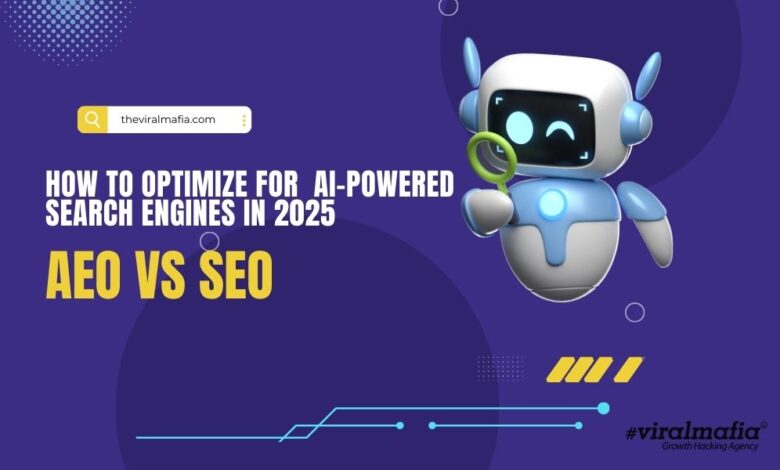AEO vs. Traditional SEO: How to Optimize for AI-Powered Search Engines in 2025

The era of typing simple keywords into the Google search bar is over. Search is evolving into a more intent-driven, AI-powered answer engine. You may have already noticed that your searches now generate a list of relevant websites on the right side of the screen. This evolution represents a shift beyond traditional SEO (Search Engine Optimization) to the next step: optimizing for AI-powered search, known as AEO (Answer Engine Optimization).
These modern search engines function as question-centered platforms. For any given query, they use AI to generate answer-centric results. The future of search is here, and it’s focused on answering questions, not just listing links.
To truly win online in 2025, you need a strategy that works for both today’s search engines and tomorrow’s AI-powered answer tools. That’s where we excel. Viral Mafia is the Digital Marketing Agency in Kozhikode for a complete SEO and AEO strategy.
What is Traditional SEO?
Everybody knows that Google is a large platform with thousands of websites and pieces of information, just like a huge library with many floors and books. Traditional SEO is the art of organizing your book so effectively that the librarian (Google) recommends it first when someone asks a question. The main goal is for your book to appear on the librarian’s shortlist of recommendations. This is the outline of traditional SEO, which focuses on key elements to achieve this.
The main elements of traditional SEO are the following:
1. Keywords: The labels
Keywords are the words or phrases that people search for to find a specific page or website. This can be simply explained with an example: imagine you have written a detailed book of authentic Kerala recipes. You need to give your book a title that easily directs the right people to it. Therefore, you must choose a title based on the terms people are searching for, such as “Best Kerala Dishes,” “Easy Authentic Recipes to Try at Home,” or “Best Onam Sadhya Recipes.” These keyword phrases act as a niche label, ensuring your book is found by its target audience, whether they discover it by chance or through a purposeful search.
2. Backlinks: Recommendations and Reputation
A backlink is a link from another website to your website. Think of backlinks as recommendations. It’s like when a respected and authoritative person suggests you try something. For example, if you have a “best chocolate cake recipe” and it is recommended by a “top chef”, that’s a powerful backlink.
Google sees each backlink as a vote of confidence. The more of these “votes” you have from high-quality sites; the more Google will view your website as an authority. A primary goal of SEO is to achieve a high ranking in Google’s search results.
3. On-Page Optimization: Organizing Your Book
On-page optimization is the process of making your website easy to find and use for both Google and visitors. It involves careful organization by using relevant keywords in page titles and content. It also includes ensuring your website loads quickly, displays properly on mobile phones, and adding descriptive text (alt text) to your images.
How Does Google Historically Rank Pages From an SEO Perspective?
Google historically crawls webpages and ranks them based on specific factors. This process involves understanding keywords, on-page SEO, and off-page SEO (such as backlinks). In simple terms, the website with the most relevant content and the strongest reputation, often built through quality backlinks, would receive the top ranking. Google used these signals to determine a site’s relevance.
Traditional SEO is effective because it is a gradual process. While it takes time to see results, the benefits are long-term. By strategically using the right keywords and earning quality backlinks, websites could signal their relevance and authority to Google. It was a direct line of communication.
What is AEO?
As we discussed with the library example, AEO (unlike traditional SEO) represents the new way of searching. The old method was like using a card catalog: there would be many books with similar titles, and you had to open each one to find the right information. AEO, however, is like a knowledgeable librarian who already understands what you need and hands you the best, most specific book for your request.
To provide a correct definition, AEO is like the process of optimizing your content so that an AI to choose the most accurate answer. AI can be ChatGPT, Alexa, Siri, or Google’s AI review.
What are the Key Differences Between SEO and AEO?
1. Focus: Direct, Concise Answers for AI tools.
SEO: It’s all about writing keyword-optimized articles so that readers are attracted and spend time on your site.
AEO: AEO is all about providing concise, accurate, and helpful answers.
AI tools don’t want to increase the bounce rates; they do want to solve the problem, therefore the content must be good and should feel authentic, even the AI will also you the content as a primary reference.
2. Optimizing for Snippets and Conversational Queries
Snippets: those are the featured answers. When you ask a particular question, there comes a short, snippet-like structure in a box. AEO aims to get your content into the box. It may be in different forms, such as:
- Answer questions directly: Structuring content to the point, right to the point for the corresponding question. No elaboration and further details.
- The style and tone: we always seek content in a literary format or using formal language. Since the AI-powered optimization platforms are often using conversational style, nowadays AI is also adopting the usual natural tone and style in content rather than the formal which seems like textbook knowledge.
- Structured Data: it is something that works better than the codes, such as the chronological order, FAQ (frequently asked questions), technical know-how, guide, demonstrating, and explaining, which can be incredibly easy for AI to understand and use.
3. Designed for Answer Engines:
Traditional search engines are designed to provide a list of links that are relevant to your query. It is all about getting on the first page. The ultimate goal of AEO is to provide one single answer to the point and accurate to. As per the algorithm of AEO, it is about being the source for that synthesized answer.
What is the Core Difference Between SEO and AEO?
- Traditional SEO is about structuring and uploading blogs and providing backlinks. AEO is about summing up the answer in a nutshell to provide an authoritative response to a question. For example, you write a chocolate cake recipe, hoping someone will need it, and upload it to your website so the article will drive traffic to your site.
- AEO is like someone looking for the recipe; the word-for-word recipe will be ready for the customer.
- The difference between SEO and AEO is that the user will no longer need to visit the blog or webpage, but they will trust the snippet of AEO as the brand becomes synonymous with the correct answer.
Conclusion
For many years, the system of SEO has improved the organization and usefulness of the internet. Even though it’s still crucial, it’s changing as a result of artificial intelligence (AI), which seeks to comprehend more than just search terms.
AEO is about shifting the mind from “How do I get clicks” to “How do I become the source of authenticity and trust”. You are no longer waiting to be placed in the algorithm; in fact, you are trying to be the best possible answer for an AI to share.
For businesses in Kozhikode ready to lead in the AI-era, Viral Mafia, being the Best SEO company in Kerala, delivers the winning combination of classic SEO and cutting-edge AEO to make your brand the answer, not just a choice. As the leading SEO agency in Kozhikode, we also strive to be the best SEO company in Cochin. We are ready to serve clients across Kerala and internationally.
Visit our website for the latest updates!






